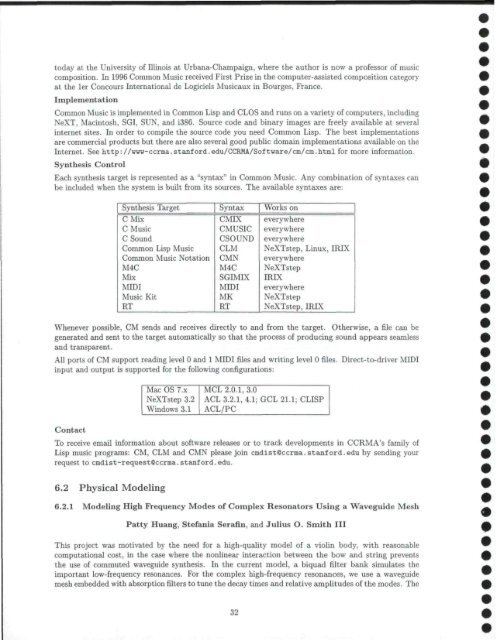CCRMA OVERVIEW - CCRMA - Stanford University
CCRMA OVERVIEW - CCRMA - Stanford University
CCRMA OVERVIEW - CCRMA - Stanford University
You also want an ePaper? Increase the reach of your titles
YUMPU automatically turns print PDFs into web optimized ePapers that Google loves.
today at the <strong>University</strong> of Illinois at Urbana-Champaign, where the author is now a professor of music<br />
composition. In 1996 Common Music received First Prize in the computer-assisted composition category<br />
at the ler Concours International de Logiciels Musicaux in Bourges, France.<br />
Implementation<br />
Common Music is implemented in Common Lisp and CLOS and runs on a variety of computers, including<br />
NeXT, Macintosh, SGI, SUN, and i386. Source code and binary images are freely available at several<br />
internet sites. In order to compile the source code you need Common Lisp. The best implementations<br />
are commercial products but there are also several good public domain implementations available on the<br />
Internet. See http://www-ccrma.stanford.edu/<strong>CCRMA</strong>/Software/cm/cm.html for more information.<br />
Synthesis Control<br />
Each synthesis target is represented as a "syntax" in Common Music. Any combination of syntaxes can<br />
be included when the system is built from its sources. The available syntaxes are:<br />
Synthesis Target<br />
CMix<br />
C Music<br />
C Sound<br />
Common Lisp Music<br />
Common Music Notation<br />
M4C<br />
Mix<br />
MIDI<br />
Music Kit<br />
RT<br />
Syntax<br />
CMIX<br />
CMUSIC<br />
CSOUND<br />
CLM<br />
CMN<br />
M4C<br />
SGIMIX<br />
MIDI<br />
MK<br />
RT<br />
Works on<br />
everywhere<br />
everywhere<br />
everywhere<br />
NeXTStep, Linux, IRIX<br />
everywhere<br />
NeXTStep<br />
IRIX<br />
everywhere<br />
NeXTStep<br />
NeXTStep, IRIX<br />
Whenever possible, CM sends and receives directly to and from the target. Otherwise, a file can be<br />
generated and sent to the target automatically so that the process of producing sound appears seamless<br />
and transparent.<br />
All ports of CM support reading level 0 and 1 MIDI files and writing level 0 files. Direct-to-driver MIDI<br />
input and output is supported for the following configurations:<br />
Contact<br />
Mac OS 7.x<br />
NeXTStep 3.2<br />
Windows 3.1<br />
MCL 2.0.1, 3.0<br />
ACL 3.2.1, 4.1; GCL 21.1; CLISP<br />
ACL/PC<br />
To receive email information about software releases or to track developments in <strong>CCRMA</strong>'s family of<br />
Lisp music programs: CM, CLM and CMN please join cmdistQccrma.stanford.edu by sending your<br />
request to cmdist-requestQccrma.stanford.edu.<br />
6.2 Physical Modeling<br />
6.2.1 Modeling High Frequency Modes of Complex Resonators Using a Waveguide Mesh<br />
Patty Huang, Stefania Serafin, and Julius O. Smith III<br />
This project was motivated by the need for a high-quality model of a violin body, with reasonable<br />
computational cost, in the case where the nonlinear interaction between the bow and string prevents<br />
the use of commuted waveguide synthesis. In the current model, a biquad filter bank simulates the<br />
important low-frequency resonances. For the complex high-frequency resonances, we use a waveguide<br />
mesh embedded with absorption filters to tune the decay times and relative amplitudes of the modes. The<br />
32

















